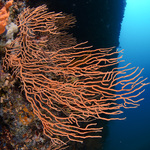REIMER James Davis
- Faculty of Science, University of the Ryukyus, Nishihara, Okinawa, Japan
- Biodiversity, Biogeography, Human impact, Marine ecology, Molecular ecology, Taxonomy
- recommender
Recommendation: 1
Reviews: 0
Recommendation: 1

Artificial reefs geographical location matters more than its age and depth for sessile invertebrate colonization in the Gulf of Lion (NorthWestern Mediterranean Sea)
A longer-term view on benthic communities on artificial reefs: it’s all about location
Recommended by James Davis Reimer based on reviews by 2 anonymous reviewersIn this study by Blouet, Bramanti, and Guizen (2022), the authors aim to tackle a long-standing data gap regarding research on marine benthic communities found on artificial reefs. The study is well thought out, and should serve as an important reference on this topic going forward.
Artificial reefs (ARs) are increasingly deployed in coastal waters around the world in order to reduce pressure on fisheries or to enhance fisheries stocks, via providing a hard substrate and complex shapes that induce the development of benthic communities, which together with the shape of the ARs themselves can provide areas for fish species to live. Much research has documented the effects of ARs on fish abundance and diversity, and documented over the short-term the benthic communities that settle and grow on ARs. However, there is a clear data gap on longer-term (e.g. greater than 10 years) trends of benthic communities on ARs. As well, any study on ARs must also account for the shape(s) of the ARs themselves, as there are numerous designs deployed, and also consider the depth of the ARs, and the age of the ARs.
The authors used the extensive ARs deployed in the Gulf of Lion in the northwestern Mediterranean to examine the effects of AR shape, depth, age (time since deployment), and location, both at local and wider regional scales, specifically examining the presence and absence of five marine species; 2 gorgonian octocorals, 1 ascidian, 1 annelid, and 1 bryozoan. Results indicate that location influenced the benthic communities above all other factors, suggesting the importance of considering the geographic location in future AR deployment and management of communities. The authors theorize that larval supply processes are important in shaping the observed patterns.
I conclude that this is an important report on AR ecology for several reasons. Firstly, the authors collected data from a variety of benthic species, including species that are habitat-forming but unfortunately perhaps not as focused on as more commercially important species. Secondly, by utilizing ARs deployed from as far back as the mid-1980s, the authors have generated longer-term information on benthic communities on ARs than what is commonly seen in the literature. Finally, the authors should be commended for their clever and hard work to incorporate all of the various factors into their analyses, and elucidating the importance of location. In fairness, this last point represents the only true limitation of the paper, as some of the statistical analyses were limited due to the small numbers of ARs fitting certain categories, and thereby limiting some of the conclusions. Still, it is very rare that a marine experimental ecologist would be in charge of AR deployment designs for 40 years, and the authors cannot be faulted for this shortcoming over which they had no control. On the contrary, the fact that the authors have performed this important work in the face of potentially limited analyses should be recognized. Marine ecology is often strongly limited by a lack of past data. In order to move past this impediment, more excellent work like the current paper is needed, conducted in a wider variety of ecosystems. I hope Blouet et al. (2022) can serve as a template for future work on a wider scale.
Reference
Blouet S, Bramanti L, Guizien K (2022) Artificial reefs geographical location matters more than shape, age and depth for sessile invertebrate colonization in the Gulf of Lion (NorthWestern Mediterranean Sea). bioRxiv, 2021.10.08.463669, ver. 4 peer-reviewed and recommended by Peer Community in Ecology. https://doi.org/10.1101/2021.10.08.463669